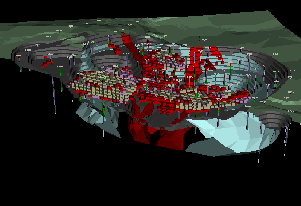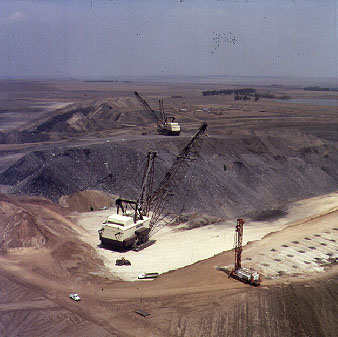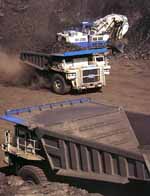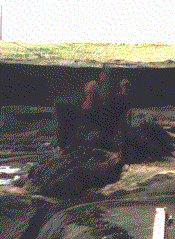Surface Mining Methods
|

|
Although the basic
concept of an open pit is quite simple, the planning required to develop a large deposit
for surface mining is a very complex and costly undertaking. In one mine, it may be
desirable to plan for blending variations in the ore so as to maintain, as nearly as
possible, a uniform feed to the mill.
At another operation it may be desirable to completely
separate two kinds of ore, as for example, a low- grade deposit where one kind of
"oxide" ore must be treated by acid leach, but a second kind of
"sulfide" ore must be treated by different methods.
|
The grade and tonnage of material available
will determine how much waste rock can be stripped, and there is often an ultimate limit
to the pit that is determined more by the economics of removing overburden than a sudden
change in the ore deposit from mineral to nonmineral bearing material. The ultimate pit
limit and the slope of the pit walls are therefore determined as much by economics and
engineering as by geological structure. Material that is relatively high grade may be left
unmined in some awkward spot extending back too deeply beneath waste.
The typical large open pit mining operation that
has been in production for 10 years and more is operating under conditions that could not
possibly have been foreseen by the original planners of the mine. Metal prices, machinery,
and milling methods are constantly changing so that the larger operations must be
periodically reevaluated, and several have been completely redeveloped from time to time
as entirely different kinds of mining and milling operations.
| Sometimes the preliminary stripping of the
waste overburden is contracted to firms specializing in earthmoving. Mining is usually done by track-mounted electric shovels in the large
operations, and by rubber-tired diesel front-end loaders in the smaller operations.
Scrapers are sometimes used in special situations. Large
bucket-wheel excavators of the kind used in European coal mines have not been applied to
metal mining, because this equipment is best adapted to softer bedded, relatively
flat-lying strata. |
 |

|
Haulage is usually by truck, although
railroads, inclined rails, and conveyor belts have been used. The conveyance unloads
directly into a primary crusher and crushed material is stored in coarse ore bins prior to
shipment to the mill. Bench level
intervals are to a large measure determined by the type of shovel or loader used, and
these are selected on the basis of the character of the ore and the manner in which it
breaks upon blasting and supports itself on the working face. |
| Blastholes are usually
drilled vertically by self-propelled, track-mounted pneumatic or rotary drills. Bulk
explosives are loaded in the holes and large volumes of ore are broken in a single blast.
Sometimes the drill holes are routinely sampled and assayed to help plan the position of
the shovels in advance of mining. Blasthole assay control is especially desirable when
exploration data are incomplete or lacking as in the case in the older pits which have
long been mined past the limits of "ore" used in original planning. |

|
|



